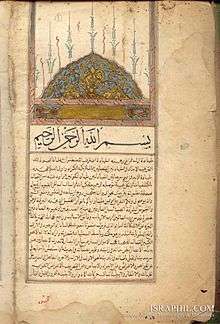Ahmad al-Buni

Ahmad ibn ‘Ali al-Buni (Arabic: أحمد البوني), his complete name is Sharaf al-Din or Shihab al-Din Ahmad ibn Ali ibn Yusuf al-Buni al-Maliki al-ifriqi (born in Annaba, Algeria died 1225) was a well known Sufi and writer on the esoteric value of letters and topics relating to mathematics, sihr (sorcery) and spirituality, but very little is known about him. Al-Buni lived in Egypt and learned from many eminent Sufi masters of his time.[1]
A contemporary of Ibn Arabi,[2] he is best known for writing one of the most important books of his era; the Shams al-Ma'arif, a book that is still regarded as the foremost occult text on talismans and divination. It was to be banned soon after as heretical by followers of the Islamic orthodoxy.
His Contribution
In Theurgy

Instead of sihr (Sorcery), this kind of magic was called Ilm al-Hikmah (Knowledge of the Wisdom), Ilm al-simiyah (Study of the Divine Names) and Ruhaniyat (Spirituality). Most of the so-called mujarrabât ("time-tested methods") books on sorcery in the Muslim world are simplified excerpts from the Shams al-ma`ârif.[3] The book remains the seminal work on Theurgy and esoteric arts to this day.
In Mathematics and Science
In c. 1200, Ahmad al-Buni showed how to construct magic squares using a simple bordering technique, but he may not have discovered the method himself. Al-Buni wrote about Latin squares and constructed, for example, 4 x 4 Latin squares using letters from one of the 99 names of Allah. His works on traditional healing remains a point of reference among Yoruba Muslim healers in Nigeria and other areas of the Muslim world.[4]
Sources of his knowledge
Ahmad al-Buni also left a list of other titles that he wrote. Unfortunately, very few of them have survived.
Source of the Essentials of Wisdom
It is stated in his work Manba’ Usul al-Hikmah (Source of the Essentials of Wisdom) that he acquired his knowledge of the esoteric properties of the letters from his personal teacher Abu Abdillah Shams al-Din al-Asfahâni. He in turn received it from Jalal al-Din Abdullah al-Bistami, who in turn received it from Shaykh al-Sarajani, who received it from Qasim al-Sarajani, who received it from Abdullah al-Babani, who received it from Asîl al-Din al-Shirazi, who received it from Abu al-Najîb al-Sahruwardi, who received it from, Mohammad ibn Mohammad Al-Ghazali al-Tusi, who received it from Ahmad al-Aswad, who received it from Hamad al-Dînuri, who received it from the master Junayd of Baghdad, who received it from Sirri Saqti, who received it from Ma’ruf al-Karkhi, who received it from Dawud Tai, who received it from Habib al Ajami, who received it from Imam Hasan al-Basri.
Magical Square
Al-Buni states in the same work that he acquired his knowledge of magical squares from Sirâj al-Dîn al-Hanafi, who acquired it from Shihab al-Dîn al-Muqaddasi, who acquired it from Shams al-Dîn al-Farisi, who acquired it from Shihab al-Dîn al-Hamadani, who acquired it from Qutb al-Dîn al-Diyâ’i, who acquired it from Muhyiddîn Ibn Arabi, who acquired it from Abu al-'Abbas Ahmad ibn al-Turîzi, who acquired it from Abu Abdillah al-Qurashi, who acquired it from Abu Madîn al-Andalusi.
Art of Letters
He also states that he acquired additional knowledge about the esoteric art of letters and the magical squares from Mohammad 'Izz al-Dîn ibn Jam’a, who acquired it from Mohammad al-Sirani, who acquired it from Shihab al-Dîn al-Hamadani, who acquired it from Qutb al-Dîn al-Dhiya’i, who acquired it from Muhyiddîn Ibn Arabi.
Occult Knowledge
Al-Buni also states that he acquired his occult knowledge from Abu al-'Abbas Ahmad ibn Maymûn al-Qastalâni, who acquired it from Abu Abdillah Mohammed al-Qurashi, who acquired it from Abu Madîn Shu'ayb ibn Hasan al-Ansari al-Andalusi, who received it from Abu Ayyub ibn Abi Sa'id al-Sanhaji al-Armuzi, who received it from Abi Muhammad ibn Nur, who received it from Abu al-Fadhl Abdullah ibn Bashr, who received it from Abu Bashr al-Hasan al-Jujari, who received it from Sirri Saqti, who received it from Dawûd al-Tâ’i, who received it from Habîb al-A'jami, who received it from Abu Bakr Muhammad ibn Sîrîn, who received it from Malik ibn Anas.
Emerald Tablet
Al-Buni also made regular mention in his work of Plato, Aristotle, Hermes, Alexander the Great, and obscure Chaldean magicians. In one of his works, he recounted a story of his discovery of a cache of manuscripts buried under the pyramids, that included a work of Hermetic thinkers.
His Influence
His work is said to have influenced the Hurufis and the New Lettrist International.[5]
He may also have indirectly influenced the late Shi'i movement of Babism, which made widespread use of talismans and magical letters.[6]
Writings
- Ahmad al-Buni Shams al-Ma'airf al-Kubra (the Great Sun of Gnoses), Cairo, 1928.
- Ahmad al-Buni, Sharh Ism Allah al-a`zam fi al-Ruhani, printed in 1357 AH or in Egypt al-Matba`at al-Mahmudiyyat al-Tujjariyyat bi'l-Azhar.
- Ahmad al-Buni, Kabs al-iktida, Oriental Manuscripts in Durham University Library
References
- ↑ By C. J. Bleeker, G. Widengren, Historia Religionum, Volume 2 Religions of the Present, p.156,
- ↑ Vincent J. Cornell, Realm of the Saint: Power and Authority in Moroccan Sufism, University of Texas Press, 1998, p. 221
- ↑ Martin van Bruinessen, "Global and local in Indonesian Islam", Southeast Asian Studies (Kyoto) vol. 37, no.2 (1999), 46-63
- ↑ Diagnosis through rosary and sand: Islamic elements in the healing custom of the Yoruba (Nigeria). Sanni A. Lagos State University, Nigeria
- ↑ Shams al-Ma'arif al-Kubra ۞ The Sun of Great Knowledge.
- ↑ [Denis MacEoin, ‘Nineteenth-Century Babi Talismans’, Studia Iranica 14:1 (1985), pp.77-98.]
Notes
- Edgar W. Francis, Mapping the Boundaries between Magic. The Names of God in the Writings of Ahmad ibn Ali al-Buni